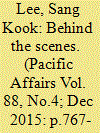| Srl | Item |
| 1 |
ID:
142069


|
|
|
|
|
| Summary/Abstract |
This study shines light on behind-the-scenes informal economic activities in the Thailand-Myanmar borderland, with a focus on unauthorized riverbank Burmese merchants, the cross-border movement of goods, and the nexus of ethnic politics and border trade. issue_image_88_4_ Border Trade by Boat_LeeAlthough unauthorized trade is labeled as “smuggling” by the state, it is withi chiwit, a “way of life,” for Burmese merchants on the riverbank and even recognized by local state agencies. The decision to smuggle is made rationally and deliberately by the merchants as part of their life trajectories, while smuggled goods cater to the needs of local people and are deeply integrated into the economy of the border towns. The cross-border movement of goods by boat also demonstrates that informal ways are still alive and facilitating border trade. It further shows that the ordering of the border is not entirely regulated by state agencies but by other social groups as well, notably ethnic groups.
|
|
|
|
|
|
|
|
|
|
|
|
|
|
|
|
| 2 |
ID:
130574


|
|
|
|
|
| Publication |
2014.
|
| Summary/Abstract |
This paper examines the territorial dispute over the Preah Vihear temple on the Thai-Cambodian border. It sheds new light on discussions of the geo-body and nationalism by engaging with cultural theorist Jean Baudrillard's notions of the simulacrum and hyperreality in association with maps. The dispute over the temple of Preah Vihear has centred on one particular map, known as the Annex 1 map, which locates the temple in Cambodian territory. The map has not remained an inanimate object, but has instead become a 'living thing' and attained something of a 'soul'. As a result, any sense of mismapping which results in the loss of territory is no other than the equivalent of a loss of the biological body, as a result of which real conflict ensues. This paper reveals the historical process of how the Annex 1 map has become a simulacrum in Baudrillard's sense of the term, to the extent that it creates an instance of hyperreality to which people are emotionally attached.
|
|
|
|
|
|
|
|
|
|
|
|
|
|
|
|
| 3 |
ID:
163108


|
|
|
|
|
| Summary/Abstract |
Using the case of Karen refugees in Japan, this paper examines how a state-driven refugee resettlement policy resulted in refugees suffering under difficult conditions and how, in turn, this drove the existing ethnic community to become an active player in assisting resettled refugees to adapt, in contest with the state. Japan was the first Asian country to initiate a refugee resettlement program in 2010. However, the government failed to consult with other stakeholders, notably the ethnic community, causing difficulties for the refugees in adapting to their new life. In helping resolving this crisis, the Karen community emerged as a legitimate actor in the governance of these refugees. The current study highlights the contest between the state and ethnic communities over resettlement programs and contributes to the understanding of the structural formation that influences refugees in the early stage of resettlement.
|
|
|
|
|
|
|
|
|
|
|
|
|
|
|
|